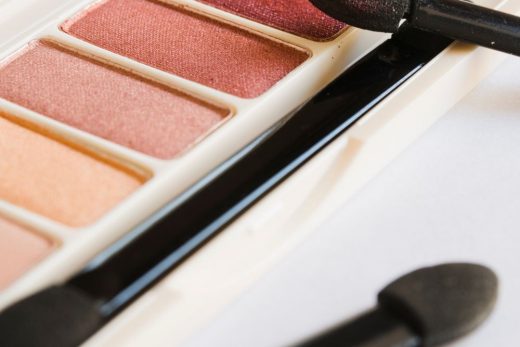Bleaching Creams
If you’re too squeamish to go under the laser, fear not! Skin lightening cream can be used to permanently lighten skin at home relatively safely. There are several unique bleaching creams out there, most of which contain the topical skin-bleaching agent hydroquinone. This ingredient is used in a wide range of products designed to lighten skin and correct hyperpigmentation. It can be used for all-over lightening or to lighten darker skin on the knees and elbows.
Hydroquinone works by limiting the skin’s ability to produce melanin through a concentration of between 2 and 4 percent, with 4 percent being the standard used in prescription-strength creams. Most people report seeing visible results within 12 weeks of consistent use, especially when SPF 35+ sunblock is applied regularly. Sunburn can complicate the medication’s ability to work properly, and can increase your risk of developing skin cancer.
In simple terms, hydroquinone can be seen as a garden hose. When clamped tightly, hydroquinone can prevent the transfer and excess production of darker pigment to a specific area. When released, if you are ultimately more prone to your skin tone darkening (as in the case of people with Melasma) then the pigment returns. Professionals often advise people experiencing re-pigmentation after stopping hydroquinone to taper off slowly, and occasionally add another antioxidant rich lotion or serum in the process.
There is also a wide range of skin lightening home remedies people try, ranging from citrus peel and yogurt treatments to milk and honey masks that affect the production of melanin. In general, these treatments work by harnessing the same potent acids used in chemical peels (especially lactic acid from milk and citric acid from oranges or lemons) to slough away the top layers of the skin to create a fresh, new appearance.
Bleaching Creams: Side Effects and Risks
Hydroquinone has gotten a bad rap over the years, and for good reason. Skin whiteners containing this ingredient were banned in South Africa years ago due to skincare companies adding harmful active ingredients like mercury and glucocorticoids to their products.
Fortunately, this additive is significantly less harmful when used on its own. With that being said, this skin whitening treatment can cause a skin issue called exogenous ochronosis, which in turn causes speckled pigmentation all over the body and face.
Lightening ingredients like hydroquinone have also been linked to liver damage when taken orally. Other side effects and risks of hydroquinone include photosensitivity, allergic reaction and toxicity, which can trigger ringing of the ears, nausea and seizures. Home skin whitening remedies are significantly less risky in terms of long-term use. As long as you use safe, gentle and natural ingredients to create home lightening creams and peels, there’s a good chance you won’t see many harmful side effects.
Skin Lightening Chemical Peels
Chemical peels have become a skincare cure-all for a range of issues, from fine lines and wrinkles to depigmentation and dark spots. These treatments work by removing the outer layer of the skin via chemical compounds and acids — primarily alpha-hydroxy acid like glycolic acid as well as salicylic acid, azelaic acid, citric acid and lactic acid. These treatments can be performed in-office by a specialist or at home using over-the-counter or homemade peels.
Choosing which type of chemical peel to use comes down to your specific skin issues. If you’re looking for an all-over lighter complexion, you’ll want to invest in one of the deeper, more intense chemical peels available. Those who just want to correct stubborn discoloration and dark spots can see big gains from gentler chemical peels. Different skin types lend themselves better to different types of peels. For example, those with acne-prone or oily skin can benefit from a lightening salicylic acid peel.
Chemical Peel Side Effects and Risks
The great thing about chemical peels is that they produce consistent results with few side effects or risks. In general, most patients report mild redness and irritation after undergoing a dermal peel. In the cases of deeper and more intense peels, permanent scarring — especially on the lower part of the face — is possible. Some people also report blemishes and viral flare-ups after having a chemical peel.
And, of course, chemical peels can cause hypopigmentation and other skin lightening effects in those with deeper skin tones. In some cases, especially after a superficial peel, hyperpigmentation (the darkening of skin) can occur. We highly recommend speaking with a board-certified plastic surgeon or dermatologist about your specific skin type and skin concerns, as he or she will be able to determine which type of acid is best suited for your skin.
Tranexamic Acid for Topical or Oral Skin Lightening
Steering away from an overly technical discussion, essentially the tranexamic acid inhibits a pathway that leads to increased pigment when exposed to UV. Studies going back to the 1980s have tested the chemical both topically and orally to improve skin tone, especially in pigmentary disorders like Melasma. Tranexamic acid applied orally is used to temporarily treat pigment irregularities, specifically in Melasma sufferers, with minimal adverse effects when monitored properly. It is not appropriate for patients with a history of heart problems, stroke, or blood clotting issues.
One study published in August of 2014 concluded that topical tranexamic acid did improve skin tone, but not as well as combination topical steroid and hydroquinone, in individuals with Melasma. Currently, topical tranexamic acid can be found in Skin Medica’s Lytera 2.0 serum among many other potent antioxidants that aid in skin tone repair. It can be found at professional seller locations like physician offices and authorized medical spas.





